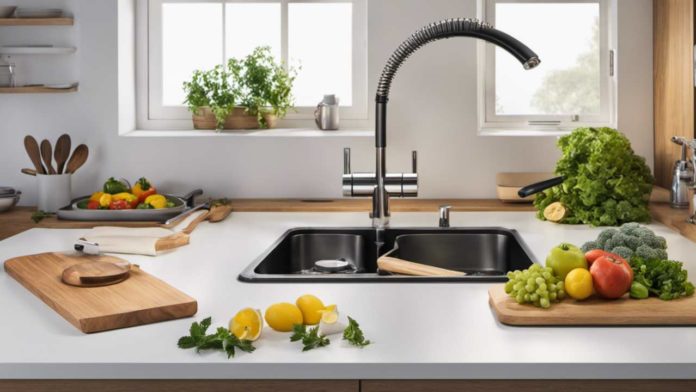Why is Nonstick Not Dishwasher Safe?
Nonstick cookware has become a staple in many kitchens due to its convenience and ease of use. However, one important thing to note is that most nonstick cookware is not dishwasher safe. This may come as a surprise to some, as the dishwasher is often seen as a time-saving solution for cleaning dirty dishes. In this article, we will explore the reasons why nonstick cookware should not be put in the dishwasher and discuss alternative methods for cleaning and maintaining nonstick pans.
The Science Behind Nonstick Coatings
To understand why nonstick cookware is not dishwasher safe, it’s important to first understand how nonstick coatings work. Nonstick coatings, such as Teflon, are made up of a thin layer of polytetrafluoroethylene (PTFE) or a similar material. This coating creates a smooth and slippery surface that prevents food from sticking to the pan, making it easier to cook and clean.
However, nonstick coatings are not as durable as other types of cookware finishes. They can be easily damaged by high heat, abrasive scrubbers, and harsh cleaning agents. Dishwashers, with their hot water, powerful jets, and abrasive detergents, can be particularly harsh on nonstick coatings, causing them to deteriorate over time.
The Effects of High Heat
One of the main reasons why nonstick cookware should not be put in the dishwasher is the high heat that dishwashers generate during the wash cycle. Most nonstick coatings have a temperature limit, typically around 500°F (260°C). Exposing nonstick pans to temperatures above this limit can cause the coating to break down and release toxic fumes.
Dishwashers typically use hot water that can reach temperatures as high as 140°F (60°C) or more. This temperature, combined with the prolonged exposure to heat during the drying cycle, can exceed the temperature limit of nonstick coatings, leading to their degradation.
Abrasive Scrubbers and Detergents
Another reason why nonstick cookware is not dishwasher safe is the use of abrasive scrubbers and harsh detergents in dishwashers. Nonstick coatings are sensitive to abrasion, and scrubbing them with abrasive materials can cause the coating to wear off or become scratched.
In addition, many dishwasher detergents contain harsh chemicals and enzymes that can be too aggressive for nonstick coatings. These chemicals can strip away the protective layer of the coating, making it less effective and more prone to sticking.
Alternative Methods for Cleaning Nonstick Cookware
While nonstick cookware should not be put in the dishwasher, there are alternative methods for cleaning and maintaining these pans. Here are a few tips:
- Hand Wash: The best way to clean nonstick cookware is by hand washing it with warm water, mild dish soap, and a soft sponge or cloth. Avoid using abrasive scrubbers or harsh cleaning agents.
- Gentle Scrubbing: If there are stubborn food residues stuck to the pan, you can use a non-abrasive scrubber or a nylon brush to gently remove them. Avoid using metal utensils or sharp objects that can scratch the nonstick coating.
- Avoid High Heat: Nonstick pans are best used over medium to low heat. Avoid using high heat settings, as this can damage the coating. Preheating the pan on low heat before adding food can help prevent sticking.
- Use Wooden or Silicone Utensils: To avoid scratching the nonstick coating, use wooden or silicone utensils instead of metal ones.
- Store Properly: To protect the nonstick coating, avoid stacking nonstick pans on top of each other. Place a soft cloth or a paper towel between pans to prevent scratches.
Conclusion
While nonstick cookware offers many benefits, it is important to remember that it is not dishwasher safe. The high heat, abrasive scrubbers, and harsh detergents used in dishwashers can damage the nonstick coating, reducing its effectiveness and lifespan. By following the alternative cleaning methods mentioned above, you can ensure that your nonstick cookware stays in good condition and continues to provide you with hassle-free cooking experiences.
Editor’s Opinion
In my opinion, it is understandable why nonstick cookware is not dishwasher safe. The delicate nature of the nonstick coating requires gentle cleaning methods to maintain its integrity. While dishwashers may seem like a convenient option, hand washing nonstick pans is a small price to pay for their longevity and performance. By taking the time to hand wash and properly care for nonstick cookware, you can enjoy its benefits for years to come.
Frequently Asked Questions (FAQs)
Q1: Can I use nonstick cookware on high heat?
A1: Nonstick cookware is not recommended for high heat cooking. The nonstick coating can deteriorate and release toxic fumes when exposed to temperatures above its limit, typically around 500°F (260°C).
Q2: How often should I replace my nonstick cookware?
A2: The lifespan of nonstick cookware can vary depending on its quality and usage. On average, nonstick pans may last for 3-5 years with proper care. However, if you notice the coating peeling or scratching, it is time to replace the pan.
Q3: Can I use metal utensils with nonstick cookware?
A3: It is best to avoid using metal utensils with nonstick cookware, as they can scratch the delicate coating. Opt for wooden or silicone utensils instead.
Q4: Are there any health risks associated with nonstick cookware?
A4: When used properly, nonstick cookware is considered safe. However, if the nonstick coating is scratched or damaged, it is advisable to replace the pan, as the exposed surface may release harmful chemicals.
Q5: Can I use nonstick cookware in the oven?
A5: Not all nonstick cookware is oven-safe. Check the manufacturer’s instructions to determine the maximum oven temperature the pan can withstand. Some nonstick pans are only oven-safe up to a certain temperature, typically around 350°F (175°C).
Sources:
- www.consumerreports.org
- www.epicurious.com
- www.cookinglight.com
- www.thekitchn.com


